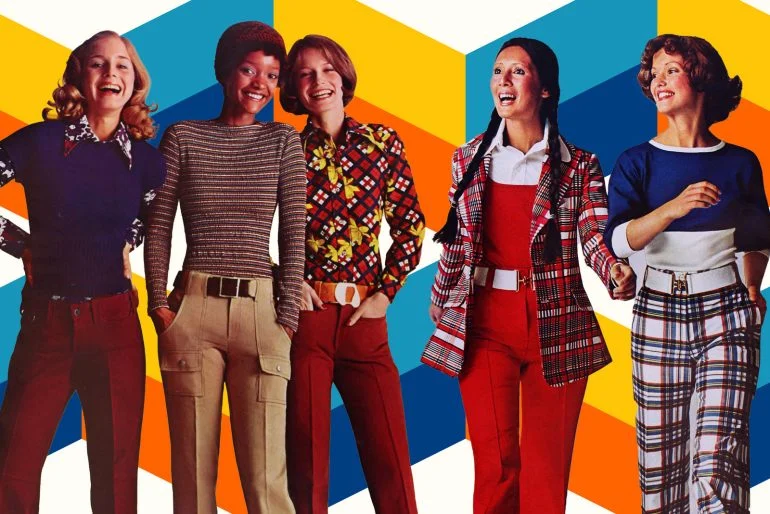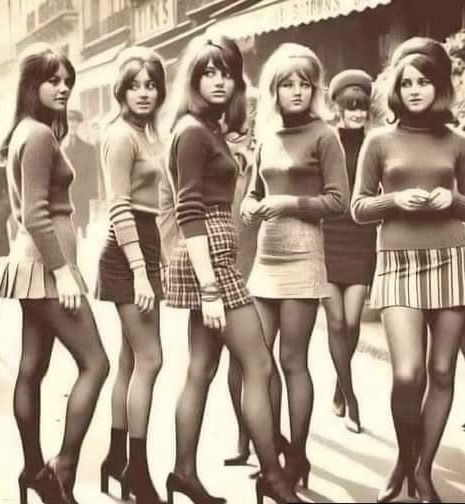In terms of fashion, the 1970s were a revolutionary decade that continues to have an impact today. The 1970s were all about individuality, glitz, and a unique sense of freedom, with a fusion of bold new concepts and vintage influences. The style of the 1970s has endured, impacting designers, celebrities, and daily wardrobes with its fitted silhouettes and disco-inspired sparkle. Let’s examine the major events and fashion movements that shaped the time period in greater detail and how they still influence contemporary styles.
The Emergence of Effortless Glamour: Comfort and Tailoring
A new, more laid-back vibe began to emerge in fashion in the early 1970s. The 1970s valued comfort without compromising style, in contrast to the tight-fitting, structured clothing of the 1950s and 1960s. As part of the broader cultural shifts of the era, formal attire gave way to more relaxed, functional attire. In particular, women started to enjoy clothing that gave them more freedom to move around socially and physically.
Fashion Icons’ Iconic Looks
Many style icons were born in the 1970s, and their fashion choices came to represent the decade. Stars like Diana Ross, Bianca Jagger, and Goldenie Hawn blazed new paths with effortlessly glamorous ensembles.
Diana Ross in Bronze Satin (1970): In a gorgeous bronze satin dress, Ross personified the glitz of the 1970s and emphasized the decade’s penchant for flowing, figure-flattering textiles.
Bianca Jagger at Studio 54 (1970): The striking, metallic lamé halter dress that Jagger wore became a staple of the glamorous nightlife at Studio 54.
These women represented a time of self-assurance, freedom, and fashion invention; they were more than just clothing designers.
Doembed Features: https://youtube.com/watch?v=ZNgR9WIIJxY
Glamour’s Power and Disco Fever
Unquestionably, the 1970s saw the rise of disco, a trend that had a significant impact on fashion. New York’s famous nightclub, Studio 54, served as the focal point for the disco mania. To make a statement beneath the bright lights of the dance floor, women adopted gaudy gowns, flashy materials, and bold cuts. The disco look was an attitude rather than merely a style.For example, Bianca Jagger’s lamé dress represented the emancipation and rebellious attitude of the era in addition to being stylish.
The Origins of Casual Chic and Sportswear
The emergence of sportswear influenced daytime fashion, but disco dominated the nightlife. Soft, comfortable separates became a wardrobe need for all women. Designers like Halston and Calvin Klein created clothing that was both fashionable and functional. Women were able to adopt a low-maintenance yet stylish lifestyle because to the popularity of polyester, a fabric that was inexpensive and simple to care for.

Halston’s Ultrasuede Separates: Halston rose to fame with his opulent yet simple designs, particularly his plush Ultrasuede separates that were ideal for the busy modern woman.Calvin Klein’s Satin Slips: Known for their understated elegance, the brand’s satin slips and straightforward jersey dresses encapsulated the spirit of an age that valued simplicity over garish decorations.
These comfortable clothes marked a dramatic change in fashion, removing the need for women to choose between elegance and functionality and elevating comfort to the same level as style.
The Development of Denim: From High Fashion to Workwear
Denim was the fabric that best captured the essence of the 1970s. Denim, which was formerly mostly associated with workwear, has come to represent teenage culture and revolt. Designer denim became popular in the 1970s, with companies like Levi’s and Wrangler setting the standard. By the middle of the decade, jeans had become a luxury item thanks to the production of high-end designers like Gloria Vanderbilt and Calvin Klein.
Calvin Klein’s Jeans (1973): Calvin Klein revolutionized the denim industry when it first entered the market. His brand transformed the perception of jeans and made them a wardrobe essential.
Fiorucci’s Stretch Denim: By including a stretch component, Fiorucci elevated denim to a new level, making it more comfortable and attractive for women of all shapes.
Polyester’s Strength: The Material of the Seventies
Although denim was a symbol of teenage culture, polyester, which was valued for its minimal maintenance and cost, became the decade’s fabric. Polyester made high fashion affordable for everyone, whether it was in tight pieces or brightly patterned dresses. It was easy to maintain and permitted stunning textures, vivid colors, and strong designs. Dresses and suits made of polyester:The development of polyester made it possible for regular women to wear dresses and suits that were fashionable, long-lasting, and minimal maintenance. The days of ironing were over because polyester was machine washable and wrinkle-free, making it ideal for busy women.Polyester’s synthetic origin eventually led to a backlash despite its usefulness, but in the 1970s, it was viewed as a groundbreaking fabric that revolutionized the fashion industry.
Boho and Tailoring: A Combination of OppositesThe blending of seemingly disparate genres was another characteristic of the 1970s. Professional women’s outfits began to feature tailored suits, but at the same time, bohemian chic—which featured giant hats, bell sleeves, and flowing skirts—was becoming more and more popular.The Custom Trousers of Jackie Kennedy (1970):Sharp lines and functional clothing were equally as important as the bohemian movement, as demonstrated by Jackie O’s classic black turtleneck and fitted pants, which epitomized the smart side of the 1970s.Bohemian Style with a Hint of Glamour:Conversely, models and celebrities adopted the bohemian style, making bell sleeves, long tunics, and flared slacks emblems of individuality and inventiveness. It was a style that embraced uniqueness and personal flair.In summary:
The Fashion of the Seventies’ Lasting LegacyThe 1970s were not only a decade marked by a shift in fashion. It was a decade that influenced how we view comfort, style, and individuality. The 1970s transformed fashion by making it more accessible, adaptable, and, most importantly, expressive of the individual’s personality. This was seen in everything from disco mania to boho chic, designer denim, and fitted suits.The ’70s helped define what it meant to accept fashion as an extension of oneself, whether it was through the glamorous evenings at Studio 54 or the stylish, carefree appearances of regular women. And the impact of that time period is still evident in our wardrobes and on today’s runways, more than 40 years later. Therefore, you’re channeling the iconic style of a decade that will always be in style the next time you put on a bohemian dress or a pair of high-waisted jeans.

